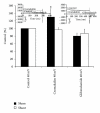ATP-Sensitive Potassium Channel Currents in Eccentrically Hypertrophied Cardiac Myocytes of Volume-Overloaded Rats
- PMID: 21845191
- PMCID: PMC3154573
- DOI: 10.1155/2011/838951
ATP-Sensitive Potassium Channel Currents in Eccentrically Hypertrophied Cardiac Myocytes of Volume-Overloaded Rats
Abstract
ATP-sensitive potassium channels (K(ATP)) protect the myocardium from hypertrophy induced by pressure-overloading. In this study, we determined the effects of these channels in volume-overloading. We compared the effects of a K(ATP) agonist and a K(ATP) antagonist on sarcolemmal transmembrane current density (pA/pF) clamped at 20 mV increments of membrane potential from -80 to +40 mV in ventricular cardiac myocytes. The basal outward potassium pA/pF in myocytes of volume-overloaded animals was significantly smaller than that in the myocytes of sham-operated controls. Treatment of the control myocytes with the K(ATP) agonist cromakalim increased pA/pF significantly. This increase was blocked by the K(ATP) antagonist glibenclamide. Treatment of the hypertrophied myocytes from volume-overloaded animals with cromakalim and in the presence and absence of glibenclamide did not change pA/pF significantly. These findings suggest that eccentrically hypertrophied cardiac myocytes from volume-overloading may be unresponsive to specific activation/inactivation of K(ATP) and that dysfunctional K(ATP) may fail to protect the myocardium from left ventricular hypertrophy associated with volume-overloading.
Figures



References
-
- Kannel WB. Incidence and epidemiology of heart failure. Heart Failure Reviews. 2000;5(2):167–173. - PubMed
-
- Turina J, Hess O, Sepulcri F, Krayenbuehl HP. Spontaneous course of aortic valve disease. European Heart Journal. 1987;8(5):471–483. - PubMed
-
- Li GR, Dong MQ. Pharmacology of cardiac potassium channels. Advances in Pharmacology. 2010;59:93–134. - PubMed
-
- Kolár F, Neckár J, Ostádal B. MCC-134, a blocker of mitochondrial and opener of sarcolemmal ATP-sensitive K+ channels, abrogates cardioprotective effects of chronic hypoxia. Physiological Research. 2005;54(4):467–471. - PubMed
Grants and funding
LinkOut - more resources
Full Text Sources

